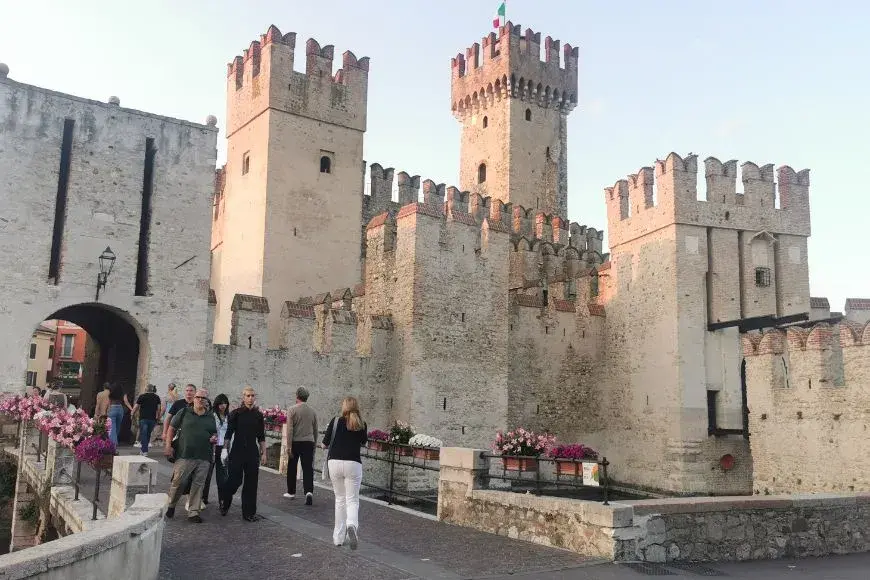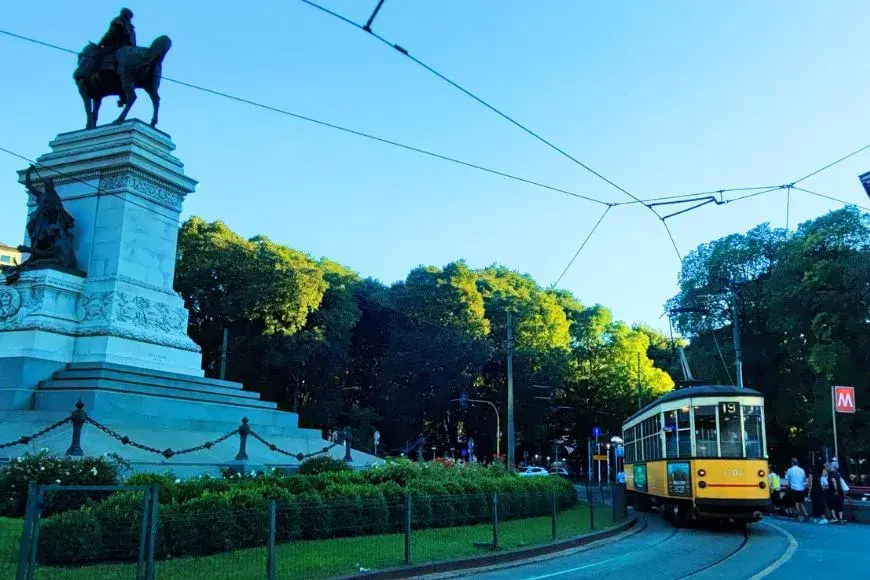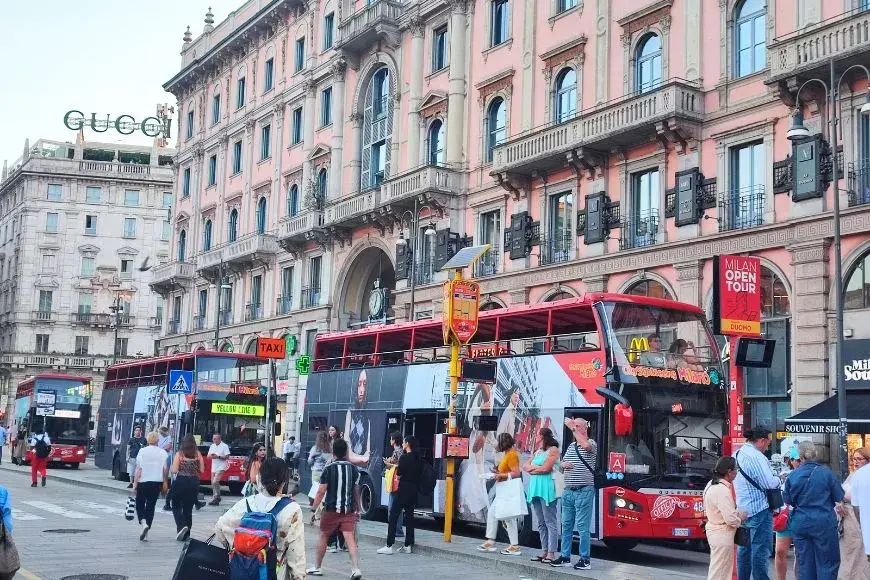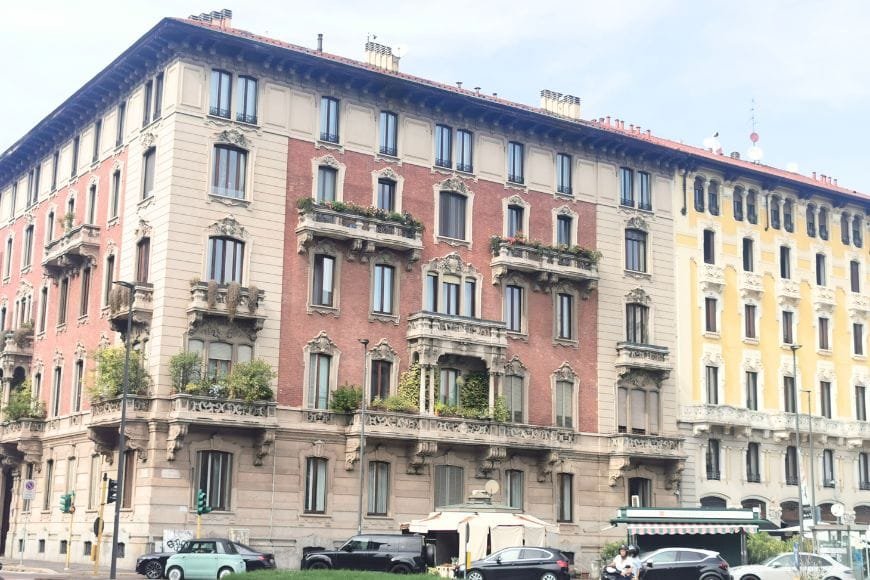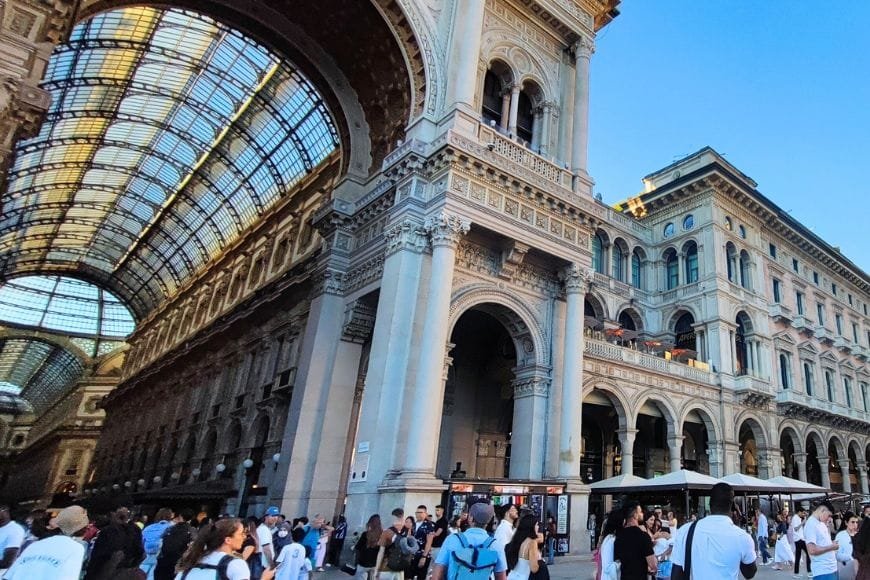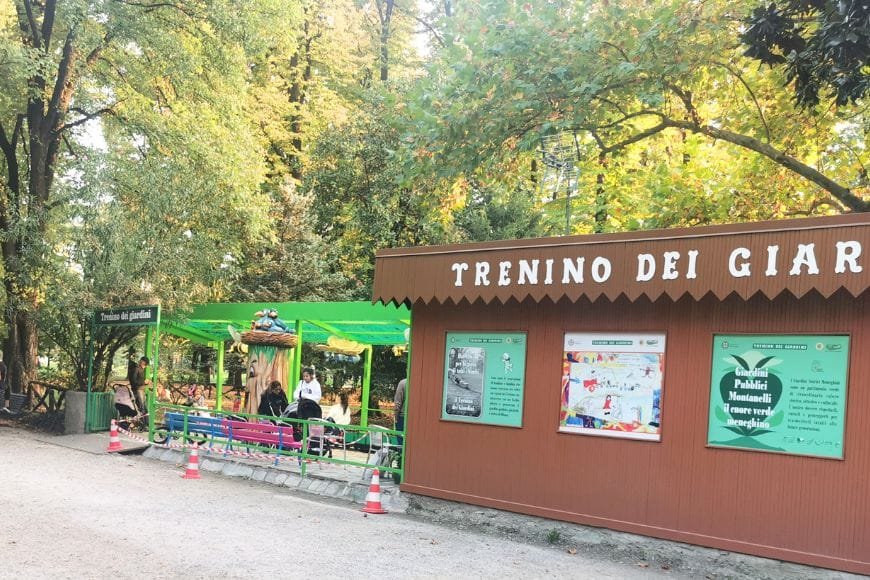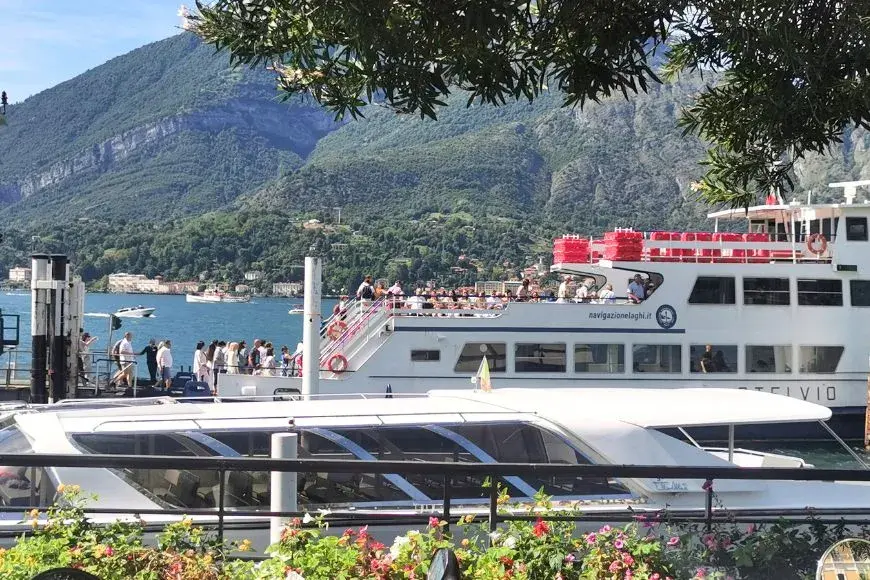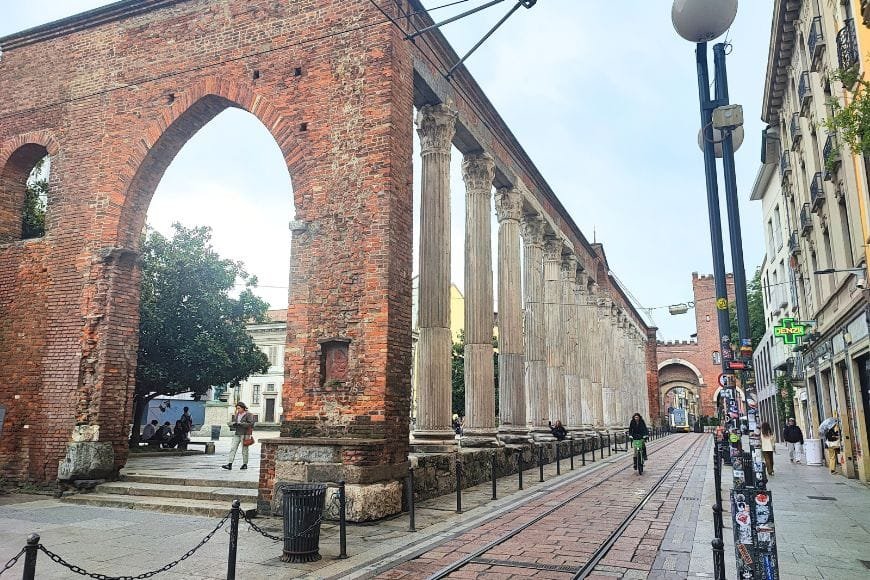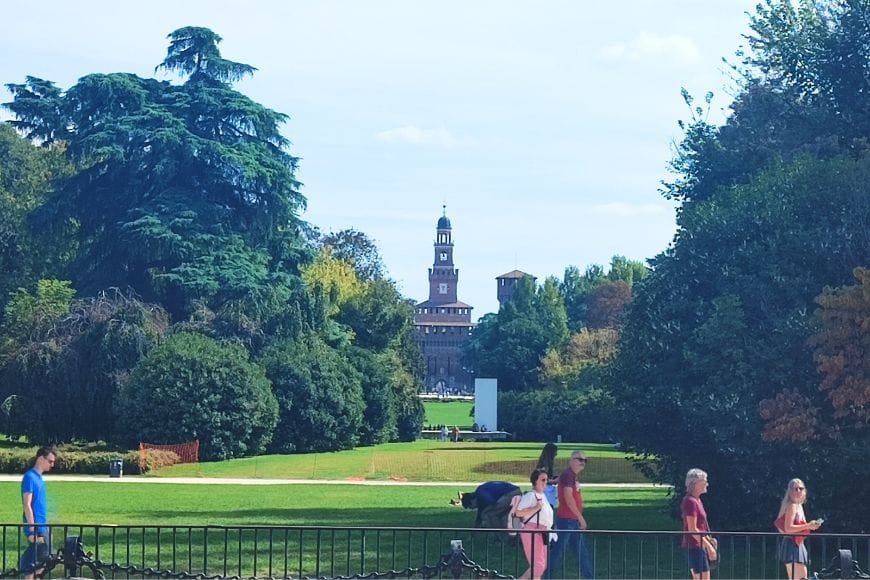Best Beaches in Italy (2025 Guide): 22 Stunning Spots to Swim, Sunbathe & Explore

by Abu | Last Updated August 24, 2025

Having lived in Italy for over 20 years, I’ve learned that the country’s coastline is just as unforgettable as its art cities and hilltop villages. From the glamorous beaches of the Amalfi Coast to the wild coves of Sardinia and the volcanic shores of Sicily, Italy’s 7,900 km (4,900 mi) of coastline offer something for every traveler.
I still remember my first swim at Spiaggia dei Conigli in Lampedusa — the water was so clear it felt like floating in glass, and the sand shimmered like powdered gold. Experiences like that convinced me that Italy’s beaches are destinations in their own right, not just a backdrop to a road trip or city break.
This guide to the best beaches in Italy is more than just a list of pretty places. For each beach, you’ll discover why it’s worth visiting, how to reach it — whether by train, bus, ferry, or car — along with tips on where to park and where to stay nearby.
Whether you’re dreaming of a family-friendly escape, a romantic hideaway, or a hidden gem known only to locals, these beaches will show you a side of Italy that belongs as much to the sea as it does to the land.
🧭 Plan Smarter: Related Italy Travel Guides
Start with our all-in-one Ultimate Italy Travel Guide (2025) — packed with itineraries, tips, and local secrets to make your trip unforgettable.
You may also find these resources helpful:
From North to South: Where to Find the Best Beaches in Italy
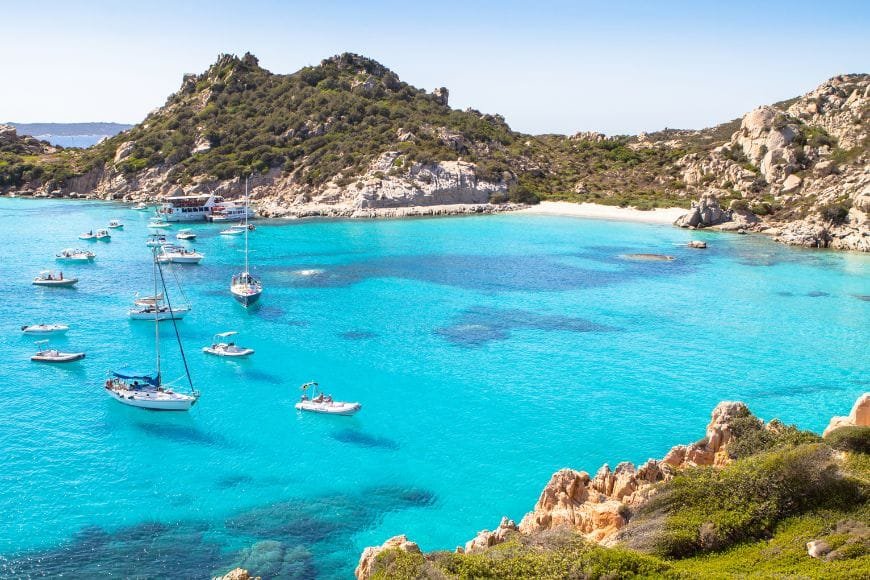
With more than 4,700 miles of shoreline, Italy’s beaches are as diverse as its landscapes. Each region has its own personality — from rugged northern coves to wild southern cliffs and island hideaways.
- Northern Italy is home to the rocky bays of Liguria and the sandy stretches near Venice, perfect for travelers combining a beach day with city trips to Milan or Florence.
- Central Italy blends culture and coast, with Tuscany’s hidden coves like Cala Violina and Elba Island, plus Lazio’s classic weekend escapes near Rome, such as Sperlonga and Sabaudia.
- Southern Italy is dramatic and colorful, from the famous Amalfi Coast and Basilicata’s wild Maratea to Calabria’s Caribbean-like waters around Tropea and Capo Vaticano.
- Sicily offers volcanic shores, family-friendly golden sands, and iconic spots like Rabbit Beach and the white cliffs of Scala dei Turchi, with easy access from Palermo, Catania, or Agrigento.
- Sardinia is Italy’s crown jewel of beaches, with Caribbean-style lagoons at La Pelosa, luxury bays on the Costa Smeralda, and adventurous hikes to coves like Cala Goloritzé and Cala Luna.
No matter where you go, Italy’s coastline offers something unique — family-friendly resorts, romantic hideaways, eco-certified Blue Flag beaches, or hidden gems loved by locals.
👉 Let’s now dive into the 22 best beaches in Italy, region by region.
Monterosso al Mare: Cinque Terre – Best Beach in Liguria
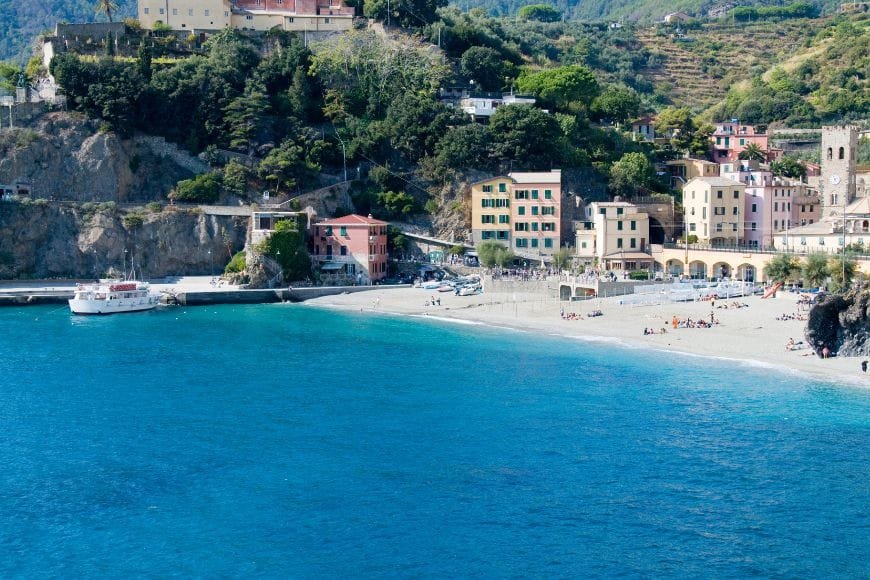
Monterosso al Mare is the largest of the Cinque Terre villages and the only one with a long sandy beach. It’s one of the best beaches in Liguria for families, offering a mix of resort comforts and authentic Italian charm.
The beach has both free sections and private lidos with umbrellas and loungers. Behind the sand, Monterosso’s promenade is lined with gelato shops, trattorias, and wine bars. Yet if you wander into the old town, you’ll still find medieval churches and pastel houses. For me, Monterosso beach is the perfect introduction to Cinque Terre — a place where you can swim in turquoise water by day and explore narrow cobbled lanes at night.
How to get there:
The easiest way is by train from Florence or Milan. Take a high-speed train to La Spezia, then transfer to the Cinque Terre local line (10–15 minutes to Monterosso). This is the most convenient option, as trains stop directly in the village. Driving is possible but not recommended — parking in Cinque Terre is extremely limited.
Where to park:
If you arrive by car, two small paid parking areas in Monterosso are located at the edge of town. They fill quickly in summer, so it’s best to arrive early.
Where to stay near Monterosso al Mare:
Monterosso has the widest range of accommodation in Cinque Terre, from boutique hotels with sea views to family-run guesthouses in the old town. Staying here also makes it easy to explore the other villages by train.
🗺️ Map Location and Directions
San Fruttuoso: Liguria – Hidden Gem on the Italian Riviera
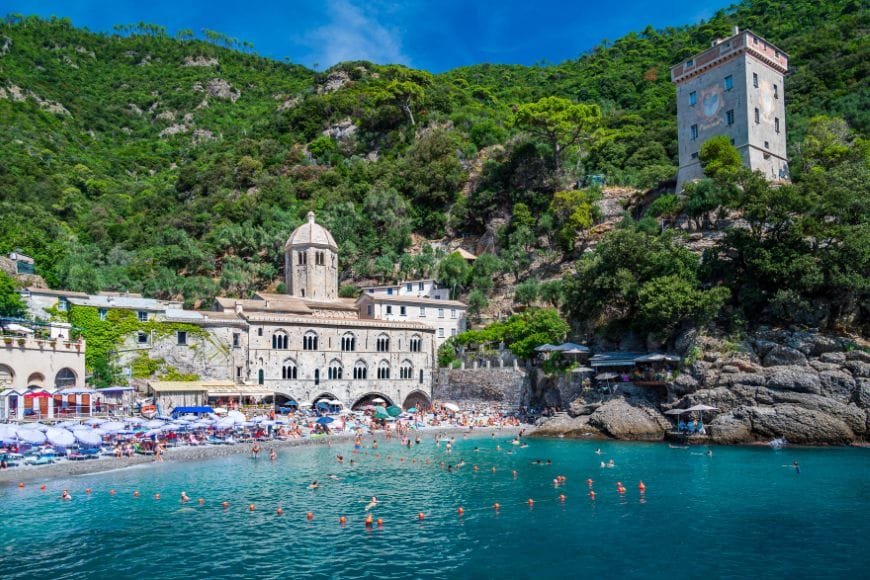
Tucked between Portofino and Camogli, San Fruttuoso beach is one of the most unique spots on the Italian Riviera. Instead of a bustling seaside town, you’ll find a secluded cove framed by lush hills and the ancient Abbey of San Fruttuoso, which seems to rise straight from the sand.
The waters here are emerald-green, clear enough to see fish swimming close to shore, and the atmosphere feels almost otherworldly compared to Italy’s crowded resorts. Having hiked down here more than once, I can say that arriving in San Fruttuoso feels like stepping back in time — a quiet oasis where history, nature, and sea all meet in one breathtaking setting.
How to get there:
The best way is by ferry from Portofino or Camogli — boats run regularly in summer and drop you right at the beach. For hikers, scenic trails lead down from Portofino’s hills (about 1.5–2 hours). Trains from Genoa or Milan take you to Camogli, where you can catch the boat. Driving is not an option, as there are no roads into San Fruttuoso.
Where to park:
If you arrive by car, park in Camogli and take the ferry. Parking is limited and fills quickly in summer, so early arrival is essential.
Where to stay near San Fruttuoso:
Most visitors come for the day, but for a truly unique experience, you can stay overnight at a small inn next to the abbey. Otherwise, choose Portofino or Camogli for more hotel options.
🗺️ Map Location and Directions
Paraggi Bay: Portofino – Luxury Beach in Liguria
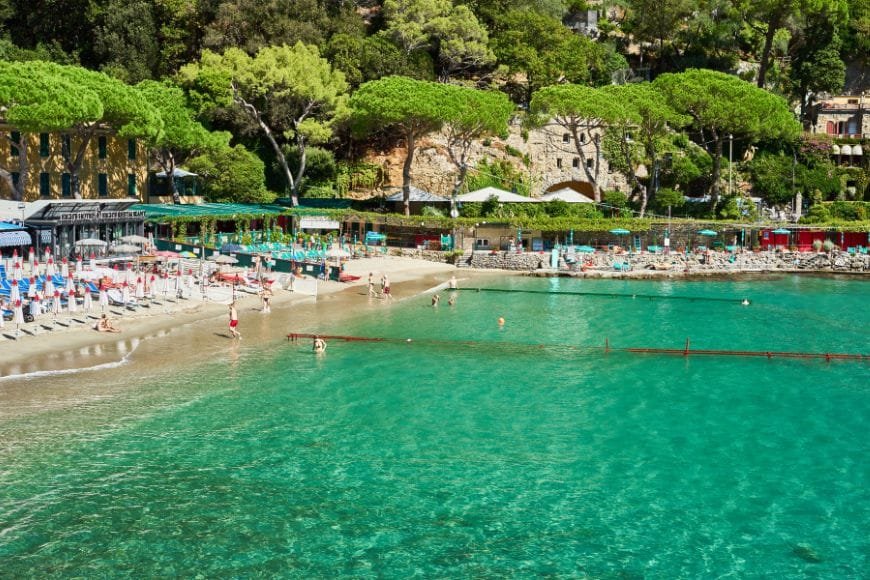
Just a short distance from Portofino, Paraggi Bay is a small but dazzling beach famous for its jade-green waters. Unlike the rocky stretches common in Liguria, Paraggi beach has soft sand and calm seas, making it ideal for swimming. It’s also known for its luxury vibe — a favorite of yachters, celebrities, and visitors who want a chic seaside escape.
I first came here on a summer afternoon, and the color of the water was so vivid it hardly looked real. Even though Paraggi is tiny, it has a unique charm: sunbathers lounging on elegant lidos, historic villas on the hills, and fishing boats bobbing in the distance.
How to get there:
From Genoa or Milan, take the train to Santa Margherita Ligure, then either walk (30 minutes) or catch a bus to Paraggi. It’s also just a short ride from Portofino. If you’re driving, the coastal road is narrow but scenic.
Where to park:
Parking near Paraggi is extremely limited and expensive in summer. It’s best to park in Santa Margherita Ligure and take a bus or walk.
Where to stay near Paraggi Bay:
For luxury, stay in Portofino itself — one of Italy’s most glamorous seaside towns. Budget-friendly travelers can find guesthouses in Santa Margherita Ligure, which also has excellent dining and nightlife.
🗺️ Map Location and Directions
Lido di Jesolo: Veneto – Best Beach Near Venice
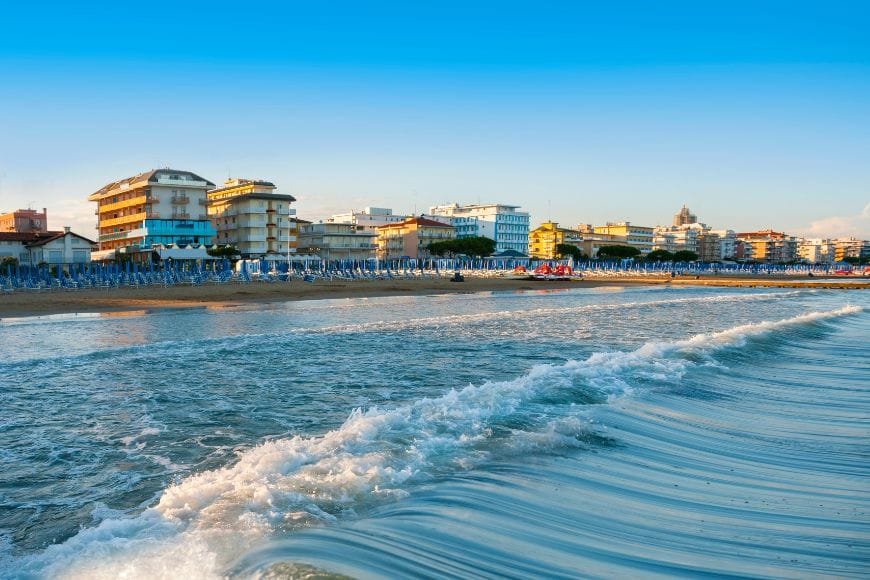
Stretching for 15 kilometers along the Adriatic, Lido di Jesolo is one of the best beaches near Venice and among the most popular in northern Italy. The wide sandy shoreline is lined with beach clubs, restaurants, and family-friendly hotels, making it a perfect seaside base for those who want both culture and relaxation.
The vibe here is lively yet welcoming. Families enjoy the shallow waters, young travelers enjoy the nightlife, and day-trippers come to combine a beach holiday with a visit to Venice. Having spent a few summer weekends here, I can say Jesolo feels like a classic Italian beach town — cheerful, busy, and full of energy.
How to get there:
From Venice, take a bus or boat connection to Punta Sabbioni, then continue by bus to Jesolo (about 1 hour). There are also direct buses from Venice’s Piazzale Roma. If you’re coming from Milan or Verona, take a train to Mestre or San Donà di Piave, then transfer by bus. Driving is straightforward, with Jesolo just an hour from Venice by car.
Where to park near Lido di Jesolo:
Lido di Jesolo has several large paid parking lots near the seafront, making it easier to arrive by car compared to Cinque Terre or Portofino.
Where to stay:
Jesolo offers a huge range of options, from beachfront resorts with pools to smaller family-run hotels. It’s also a popular choice for travelers who want a more affordable base near Venice.
🗺️ Map Location and Directions
Get our FREE Italy
Travel Guide
E-Book
This printable guide is your ultimate companion for exploring Italy, with insider tips, detailed itineraries, transportation advice, must-see attractions, and more.

Cala Violina: Tuscany
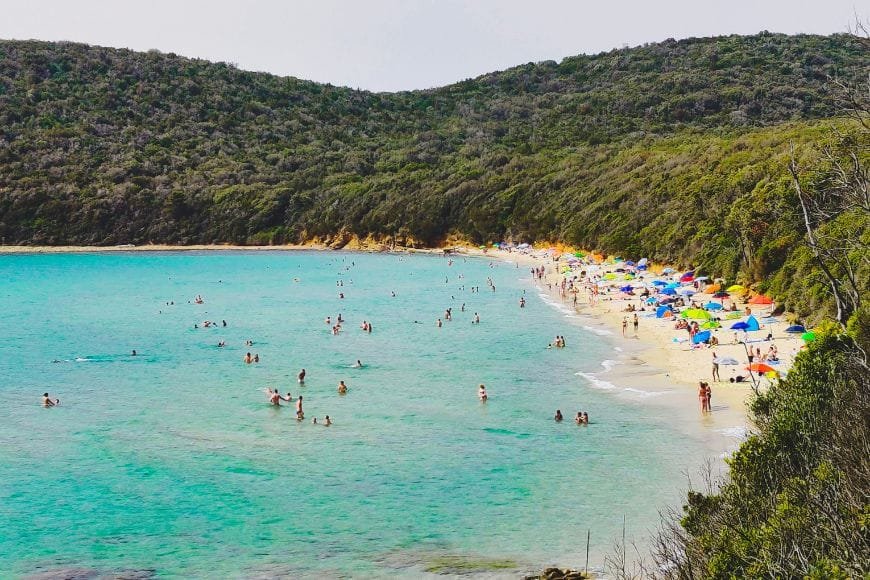
Hidden inside the Bandite di Scarlino Nature Reserve, Cala Violina beach is one of the best beaches in Tuscany and a favorite among locals. Its name comes from the sound the sand makes when you walk on it — said to resemble the notes of a violin. The cove is framed by pine forests and turquoise waters, creating a peaceful, almost untouched atmosphere.
I still remember hiking through the shady forest trail and finally seeing Cala Violina open up in front of me — the contrast of green pines against the deep blue sea is unforgettable. Unlike the crowded resorts along the Tuscan coast, Cala Violina feels wild, natural, and wonderfully calm.
How to get there:
The nearest famous city is Florence. From Florence, take a train to Follonica, then continue by taxi or bus to the trailhead. From there, it’s about a 30-minute walk through the forest. Driving from Florence or Pisa takes around 2.5 hours.
Where to park :
There’s a small paid parking lot at the trail entrance, which fills quickly in summer. Arrive early if coming by car.
Where to stay near Cala Violina:
Stay in Follonica or Scarlino, where you’ll find B&Bs and seaside hotels. For a quieter base, agriturismi (farm stays) in the Tuscan countryside offer an authentic experience.
🗺️ Map Location and Directions
Sansone Beach: Elba Island – White Pebble Paradise
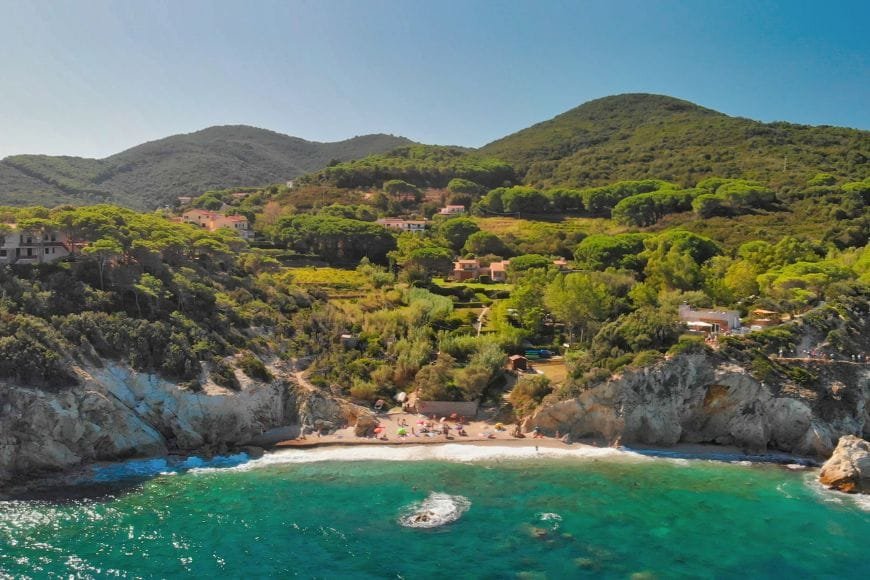
On the northern coast of Elba, Spiaggia di Sansone is one of the island’s most photographed spots. The beach is covered in smooth white pebbles that make the water glow a vivid shade of turquoise, often compared to the Caribbean.
I’ve been to Elba several times, and Sansone always feels special — partly because of the stunning colors, and partly because it’s quieter than the island’s more famous beaches. The cliffs surrounding the cove add to the wild, untouched atmosphere, making it a dream for swimmers and photographers.
How to get there:
The easiest route is via Florence or Pisa. From either city, take a train to Piombino Marittima, then a ferry to Elba. Once on the island, local buses and taxis can take you close to Sansone, though the final approach is a short walk down a rocky path.
Where to park:
Limited roadside parking is available near the trail to Sansone. Spaces are scarce in summer, so public transport or arriving early is best.
Where to stay near Sansone Beach:
Stay in Portoferraio, the main town on Elba, which is just a short drive away. It has hotels, guesthouses, and plenty of dining options.
🗺️ Map Location and Directions
Sperlonga: Lazio – Best Beach Near Rome
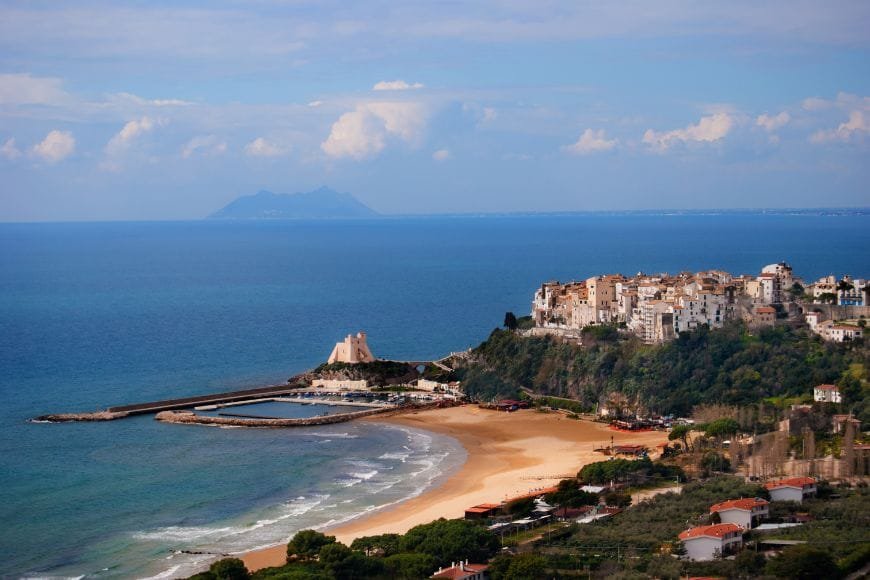
Just 2 hours south of Rome, Sperlonga is one of the best beaches near Rome and a beloved weekend escape for locals. The town itself is a vision of whitewashed houses perched on a promontory, while below stretches a long sandy beach lapped by gentle waves.
I’ve always found Sperlonga to be a perfect mix: it has the charm of a Mediterranean village, calm, shallow waters ideal for swimming, and a relaxed vibe that makes it easy to spend an entire day without noticing the time pass.
How to get there:
From Rome, take a train to Fondi-Sperlonga (about 1 hour), then a short bus or taxi to the town and beach. From Naples, the same line runs north with a stop at Fondi. Driving from either Rome or Naples takes about 2 hours.
Where to park:
Paid parking lots are available near the beach and around the town, but they fill quickly on weekends. If you drive, arrive early.
Where to stay near Sperlonga:
Sperlonga has boutique hotels in the old town and beach resorts along the coast. Many visitors choose to stay overnight to enjoy quieter evenings after the day-trippers leave.
🗺️ Map Location and Directions
Sabaudia: Lazio – Natural Beach by the Dunes
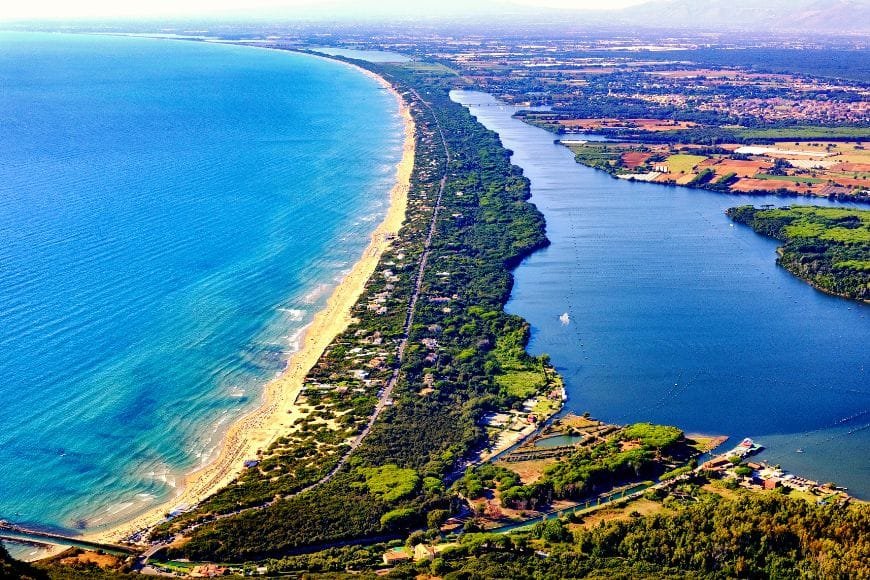
South of Rome, Sabaudia beach is one of the most natural stretches of coast in Lazio. Backed by sand dunes and part of Circeo National Park, it offers a wilder experience than many Italian beaches. The shoreline runs for miles, so even in the summer you can find quieter spots away from the crowds.
The first time I visited, I was struck by how unspoiled it felt — just sand, sea, and dunes stretching into the distance. It’s a favorite for Romans who want a break from the city, but it rarely feels chaotic compared to beaches closer to Rome.
How to get there:
From Rome, take a train to Priverno-Fossanova, then continue by bus or taxi to Sabaudia. Driving from Rome takes about 1.5 hours, making it a popular weekend trip.
Where to park:
There are several paid parking areas near the main beach access points, though walking across the dunes is usually required.
Where to stay near Sabaudia:
Small hotels, B&Bs, and guesthouses can be found in Sabaudia town. For nature lovers, agriturismi in the nearby countryside offer a peaceful stay.
🗺️ Map Location and Directions
Marina di Praia: Amalfi Coast – Hidden Cove in Campania
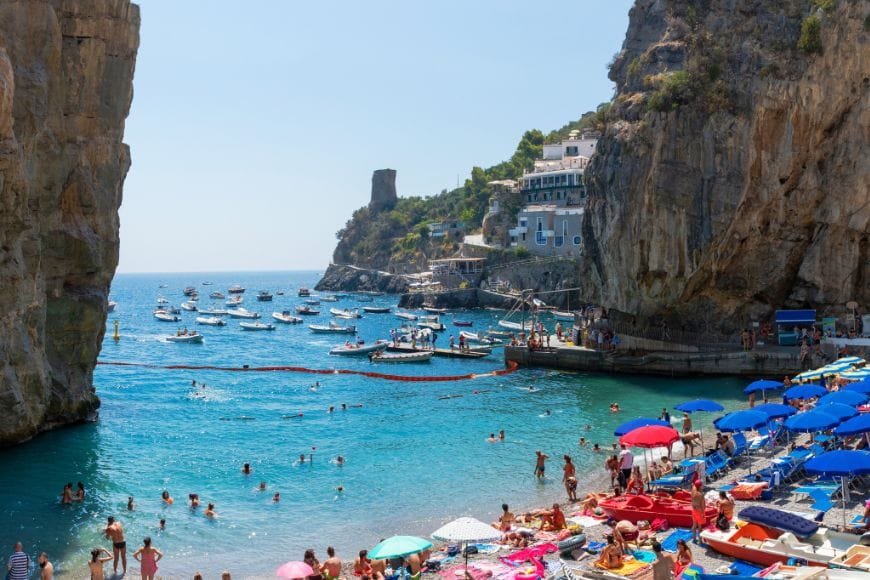
On a coast famous for dramatic cliffs and glamorous towns, Marina di Praia feels like a secret. This tiny cove lies between towering rock walls, with colorful boats pulled onto the sand and beach clubs tucked along the shore. It’s one of the best beaches on the Amalfi Coast for those who want an intimate, local vibe rather than a long sandy stretch.
I first came here while exploring Praiano, and it felt like stepping into another world — quiet, sheltered, and full of charm. The sea sparkles in shades of deep blue, and the surrounding cliffs make it feel like a private hideaway.
How to get there:
From Naples, take a train to Sorrento, then continue by SITA bus along the Amalfi Coast to Praiano. Marina di Praia is a short walk from the main road. Driving is possible, but traffic and parking on the Amalfi Coast can be challenging in peak summer.
Where to park:
A small paid parking area is available near the beach, but spaces are limited. In summer, it’s best to rely on buses.
Where to stay near Marina di Praia:
Stay in Praiano, which is quieter than Amalfi or Positano but still full of charming hotels and sea-view B&Bs.
🗺️ Map Location and Directions
Atrani Beach: Amalfi Coast – Italy’s Smallest Seaside Village
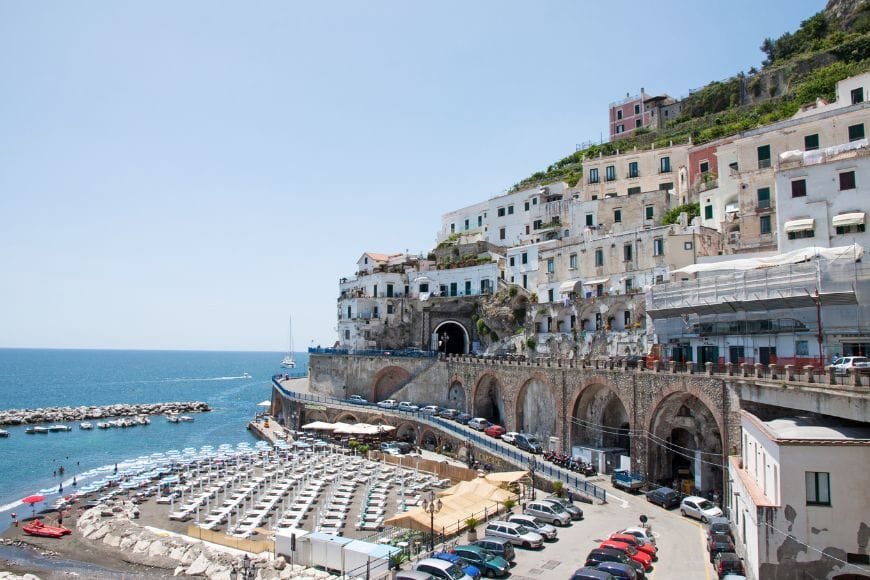
Just a short stroll from Amalfi town, Atrani beach is one of the most authentic corners of the coast. The golden sand is framed by pastel-colored houses, tiny piazzas, and fishing boats that remind you this is still a working village. It’s less crowded than Amalfi’s main beach, making it one of the best family beaches on the Amalfi Coast.
One of my favorite evenings was spent here, swimming at sunset and then wandering into Atrani’s quiet piazza for a plate of fresh seafood. Compared to bustling Amalfi, Atrani feels like a hidden gem where time slows down.
How to get there:
From Naples, take a train to Salerno, then continue by bus or ferry to Amalfi. From there, it’s a 10-minute walk or a 2-minute bus ride to Atrani. Driving is possible, but parking is very limited.
Where to park:
A small parking garage exists between Amalfi and Atrani, but it fills quickly. The best option is to park in Salerno and come by bus or ferry.
Where to stay near Atrani Beach:
Atrani has a few charming guesthouses right in the village. For more options, stay in nearby Amalfi town and enjoy the short walk over.
🗺️ Map Location and Directions
Fiordo di Furore: Amalfi Coast – Italy’s Fjord Beach
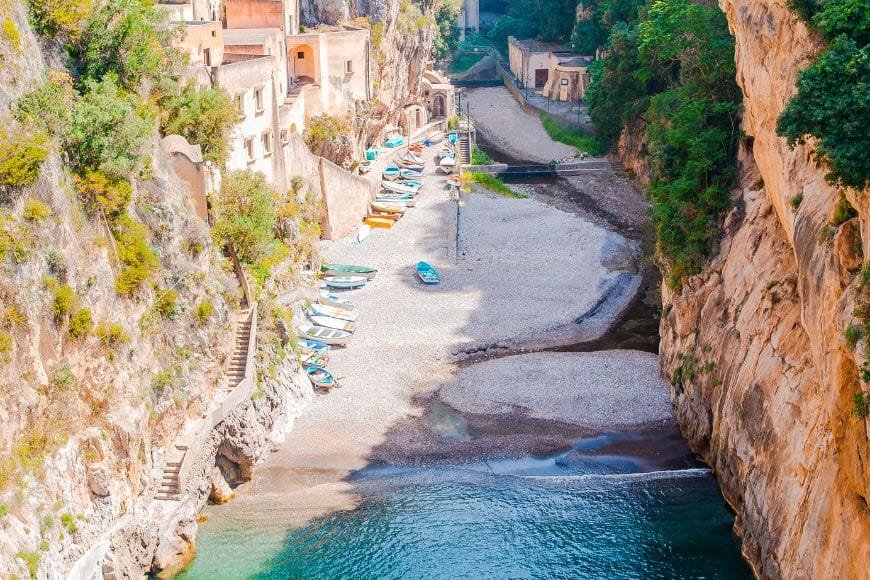
Unique among Italy’s beaches, the Fiordo di Furore is a narrow fjord-like inlet with emerald water beneath a dramatic stone bridge. This is one of the most unique beaches in Italy, tiny but unforgettable. The steep cliffs create natural shade, making it a welcome stop on hot summer days.
I’ll never forget the first time I saw it from above, driving along the Amalfi Coast road — the bridge spans the gorge, and below, the hidden cove looks like something out of a painting.
How to get there:
From Naples or Salerno, take a train to Sorrento or Amalfi, then continue by SITA bus to Furore. The beach lies directly beneath the main road bridge, with steps leading down. Driving along the Amalfi Coast road also passes right over the fjord.
Where to park:
Limited roadside parking is available near the bridge, but spaces are insufficient. It’s easier to use buses.
Where to stay near Fiordo di Furore:
Stay in Amalfi or Praiano, both just a short bus ride away.
🗺️ Map Location and Directions
Maratea: Basilicata – The Pearl of the Tyrrhenian
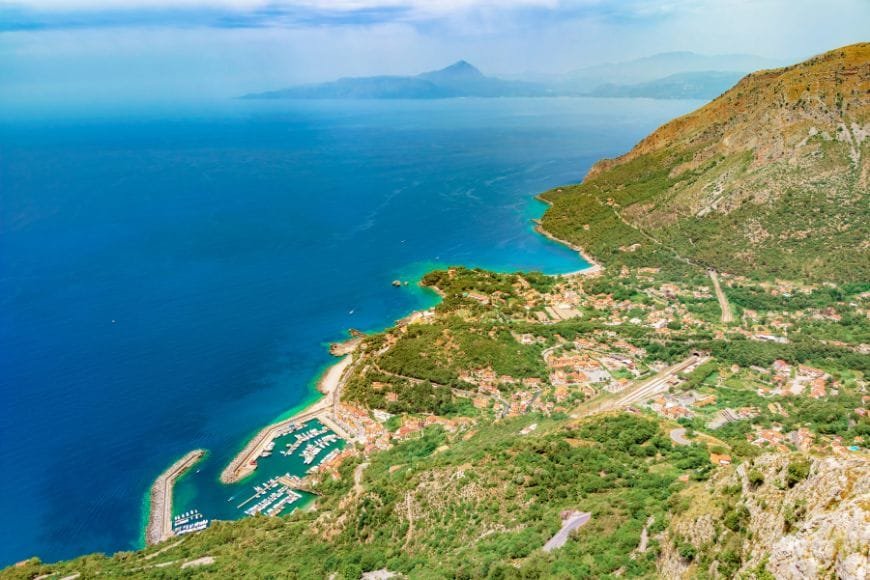
Known as the “Pearl of the Tyrrhenian,” Maratea is one of southern Italy’s most underrated coastal towns. The coastline here is rugged, with cliffs, hidden coves, and small pebble beaches that feel wonderfully wild. It’s not only one of the best beaches in Basilicata, but also a destination where nature and history meet — the town is crowned by a giant statue of Christ overlooking the sea.
What I love about Maratea is the atmosphere: peaceful, authentic, and far less touristy than Campania or Calabria. The beaches here feel like secrets, shared mostly by Italians in the know.
How to get there:
From Naples, take a train south along the Tyrrhenian line directly to Maratea (about 3 hours). Driving is also possible, with Maratea about 2.5 hours from Naples by car.
Where to park:
Paid parking is available near the main town and marina. Some of the smaller coves require walking down from the roadside.
Where to stay near Maratea:
Stay in Maratea town, where boutique hotels and family-run inns offer sea views. For a special experience, some hotels are built right into the cliffs.
🗺️ Map Location and Directions
Tropea Beach: Calabria
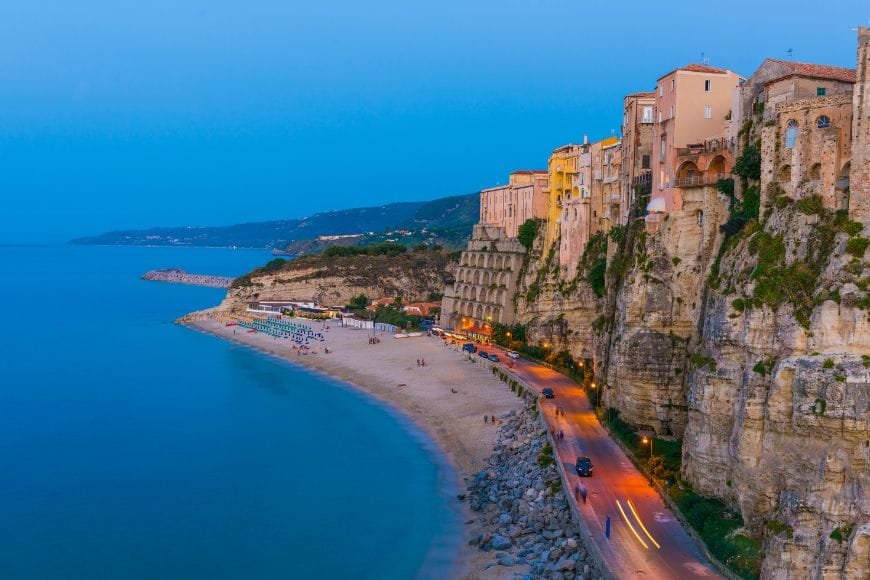
Tropea is often called the “Jewel of Calabria”, and it’s easy to see why. This stretch of coast is regularly listed among the best beaches in Italy thanks to its golden sand and turquoise water framed by dramatic cliffs. Above the shore, the historic town of Tropea overlooks the Tyrrhenian Sea, with pastel houses glowing at sunset.
On clear days, you can spot the Aeolian Islands in the distance, while Santa Maria dell’Isola — a centuries-old church perched on its own rocky promontory — creates one of the most iconic views in southern Italy beaches. I still remember my first evening here, sitting on the sand as locals wandered down with gelato, the cliffs glowing pink in the fading light.
Having lived in Italy for over 20 years, Tropea remains one of my personal favorites. It’s not only one of the best beaches in Calabria, but also a place where you can enjoy authentic food, fiery sunsets, and the slow rhythm of southern life.
How to get there:
The easiest way is by train from Rome or Naples. Take a high-speed service south to Lamezia Terme, then transfer to a regional train directly to Tropea (about 1 hour). The station is just a 10-minute walk from the beach. Buses also connect Tropea with nearby villages. If you’re driving, it’s around 1 hour from Lamezia Terme Airport, though roads get busy in summer.
Where to park :
Several paid parking lots in Tropea are available near the marina and just outside the historic center. Free parking exists further uphill, but it means a longer walk down to the beach.
Where to stay near Tropea Beach:
For the best experience, stay in the historic center of Tropea, where boutique hotels and B&Bs overlook the sea and the famous Santa Maria dell’Isola. Budget guesthouses are also available near the station.
🗺️ Map Location and Directions
Get our FREE Italy
Travel Guide
E-Book
This printable guide is your ultimate companion for exploring Italy, with insider tips, detailed itineraries, transportation advice, must-see attractions, and more.

Capo Vaticano: Calabria – Rugged Coastline & Caribbean Waters
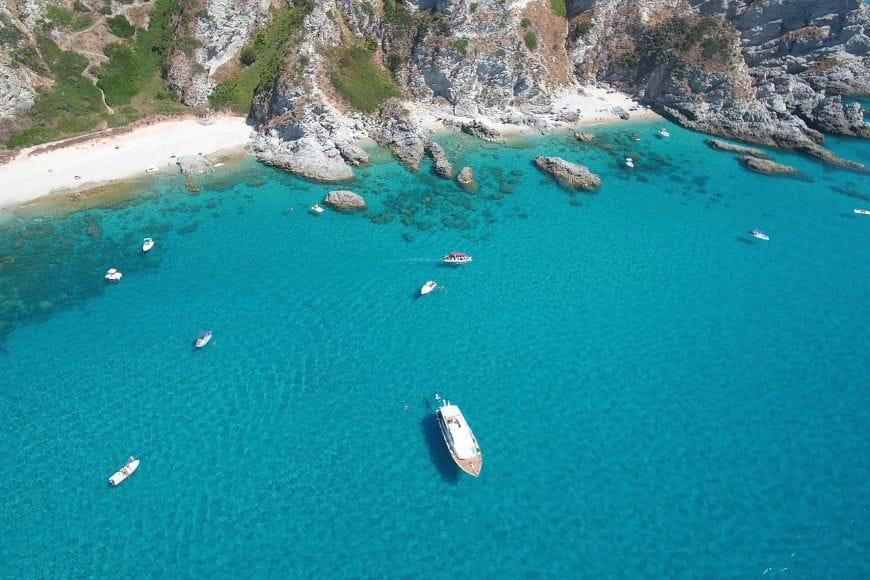
Just a few kilometers from Tropea, Capo Vaticano is famous for its rugged headland and hidden coves that many consider among the best beaches in Calabria. The water here is crystal-clear, with shades of turquoise that rival the Caribbean, and the cliffs are dotted with panoramic viewpoints.
I once came here on a hot August day and was amazed that even in high season, you can still find quieter coves if you’re willing to walk a little. Snorkeling is excellent, with plenty of marine life in the rocky bays.
How to get there:
From Rome or Naples, take a train to Lamezia Terme, then connect to a regional train toward Tropea. Local buses and taxis link Tropea with Capo Vaticano. Driving is also easy, with Capo Vaticano about 20 minutes by car from Tropea.
Where to park:
Several small parking areas exist near the main beach access points, though they can be crowded in summer.
Where to stay near Capo Vaticano:
Stay in Tropea for more options, or choose one of the seaside resorts near Capo Vaticano itself, many of which overlook the cliffs.
🗺️ Map Location and Directions
Conigli Beach: Lampedusa – Rabbit Beach, Sicily
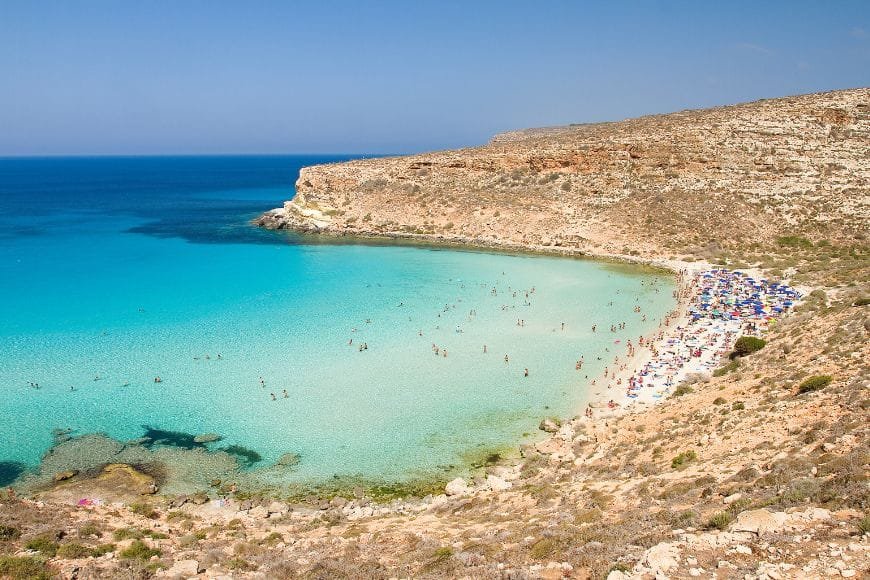
Often ranked among the best beaches in the world, Spiaggia dei Conigli (Rabbit Beach) on Lampedusa is pure paradise. The sand is soft and white, the water a brilliant shade of turquoise, and the shallow lagoon makes it feel like a giant natural swimming pool. It’s also a protected reserve, home to loggerhead sea turtles that return here to nest.
The first time I visited, I was stunned by how untouched it felt — no lidos, no loud music, just nature at its best. Sitting on the sand, with cliffs behind and the sea stretching endlessly ahead, you understand why this beach is considered one of the most famous beaches in Italy.
How to get there:
The easiest way is flying from Palermo or Catania to Lampedusa Island (about 1 hour). From the town of Lampedusa, buses and taxis run to the beach entrance, followed by a 15-minute walk down to the sand.
Where to park:
A small parking area is available near the trailhead if you rent a car or scooter on the island.
Where to stay near Spiaggia dei Conigli:
Stay in Lampedusa town, where guesthouses and boutique hotels offer easy access to both Rabbit Beach and the island’s other coves.
🗺️ Map Location and Directions
San Vito Lo Capo: Sicily – Family Friendly Beach Escape
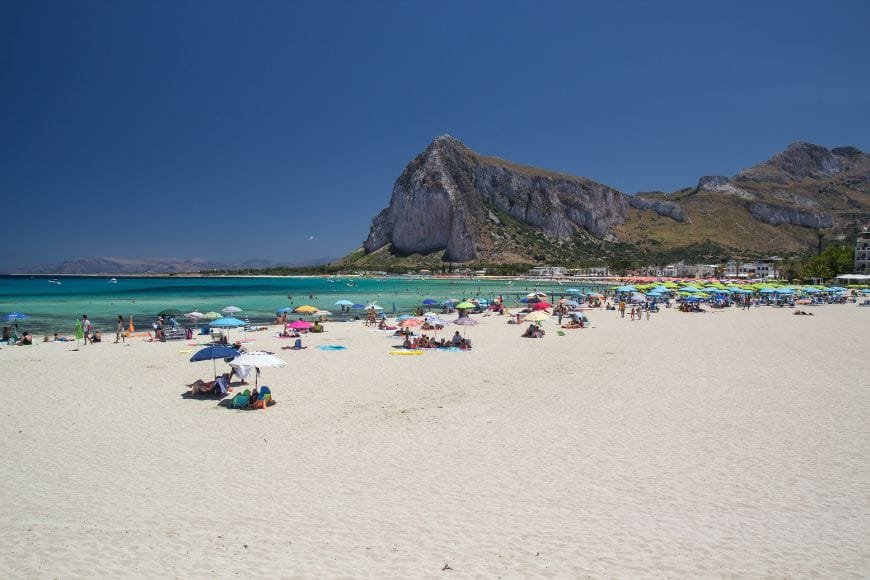
In northwestern Sicily, San Vito Lo Capo is one of the best family beaches in Sicily. The long crescent of golden sand and shallow, calm water makes it perfect for children, while the backdrop of Monte Monaco adds dramatic scenery.
I’ve always loved San Vito for its cheerful summer vibe — umbrellas lined up on the sand, families sharing gelato, and a town that feels welcoming without being overwhelming. The couscous festival held here each September is another reason to visit, blending beach life with Sicilian culture.
How to get there:
From Palermo, buses run directly to San Vito Lo Capo (around 3 hours). Driving from Palermo takes about 1.5–2 hours.
Where to park:
Large paid parking areas are available at the edge of town, with shuttles running to the beach in high season.
Where to stay near San Vito Lo Capo:
Stay in San Vito Lo Capo town for easy beach access — hotels and B&Bs range from budget to boutique.
🗺️ Map Location and Directions
Scala dei Turchi: Sicily – The White Cliffs of Agrigento
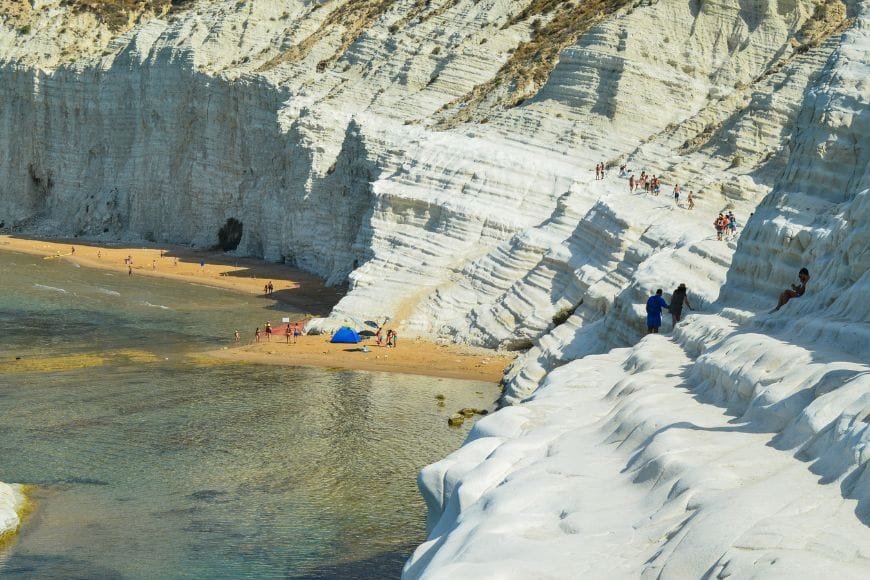
Unlike any other place in Italy, Scala dei Turchi is a dazzling white limestone cliff that looks like a giant staircase leading into the sea. While the beach itself is narrow, the cliffs are the star attraction — gleaming in the sun and glowing orange at sunset. It’s one of the most unique beaches in Sicily and perfect for photography.
The first time I climbed the cliffs, the surface felt smooth underfoot, shaped by centuries of wind and waves. It’s an unforgettable sight, especially when seen after visiting the ancient ruins of Agrigento nearby.
How to get there:
From Agrigento, buses run to Realmonte, the closest town to Scala dei Turchi (about 20 minutes). From Palermo, take a train or bus to Agrigento first (2–3 hours). Driving is also an option, with parking areas near the cliffs.
Where to park:
Several private paid parking lots are available near the beach access points.
Where to stay near Scala dei Turchi:
Stay in Agrigento for more hotel options, or in Realmonte if you prefer to be closer to the cliffs.
🗺️ Map Location and Directions
Isola Bella: Taormina – The Pearl of the Ionian
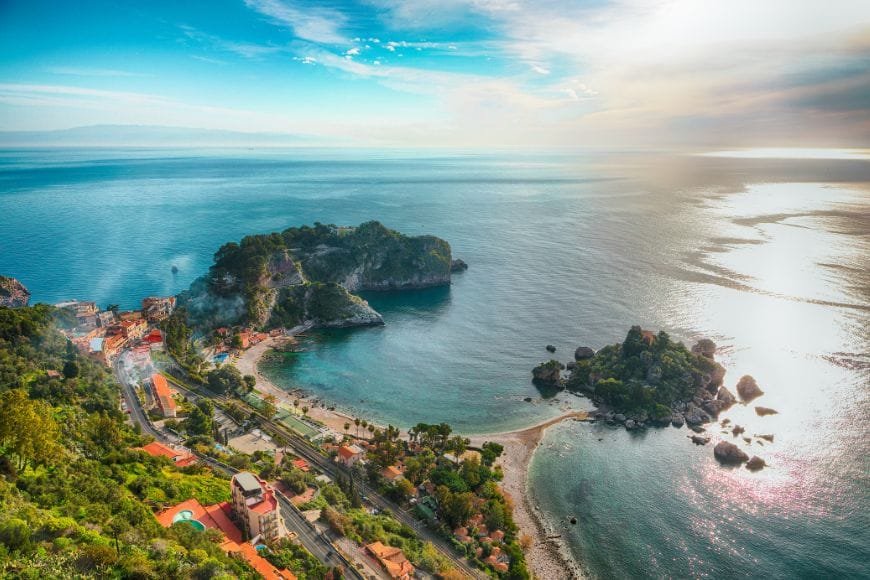
Just below the famous town of Taormina, Isola Bella is a small rocky island connected to the mainland by a narrow strip of sand that appears and disappears with the tide. Surrounded by lush vegetation and clear blue water, it’s often called the “Pearl of the Ionian Sea.”
I still remember walking down from Taormina’s Greek Theater and seeing the island below — it looked like a jewel floating in the sea. Swimming here feels magical, with fish darting among the rocks and the backdrop of Taormina above.
How to get there:
From Catania, trains run to Taormina-Giardini station (about 1 hour), followed by a bus or cable car down to the beach. Driving from Catania takes about an hour as well.
Where to park:
A paid parking garage is available near the cable car station in Taormina, with connections down to Isola Bella.
Where to stay near Isola Bella:
Stay in Taormina, where boutique hotels and guesthouses offer stunning views over the Ionian coast.
🗺️ Map Location and Directions
La Pelosa: Stintino – One of the Best Beaches in Sardinia
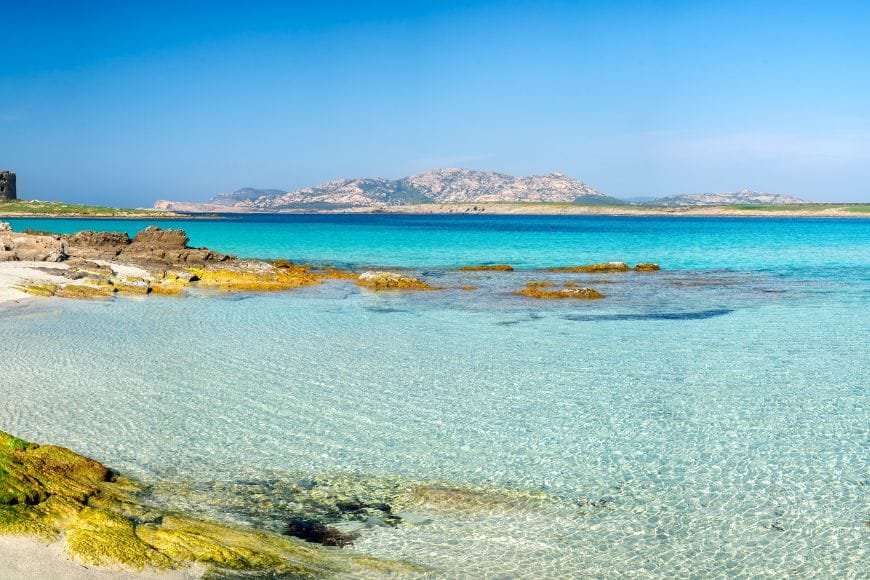
Famous for its impossibly turquoise waters and soft white sand, La Pelosa beach near Stintino is often described as one of the best beaches in Sardinia and even in all of Italy. The shallow, transparent lagoon looks almost tropical, with the 16th-century Torre della Pelosa tower standing guard offshore.
The first time I waded into the water here, it was so clear I could see every detail of the seabed. Even in summer, La Pelosa has a magical beauty that makes it worth the trip north.
How to get there:
From Alghero, buses run to Stintino in about 1.5 hours. Driving is the most convenient option, with Stintino about 45 minutes from Alghero by car.
Where to park:
There are several paid parking areas near La Pelosa, but they fill up quickly in July and August. A beach pass is required in peak season, and numbers are limited.
Where to stay near La Pelosa:
Stay in Stintino, a small fishing town nearby, or base yourself in Alghero for more accommodation choices and a lively atmosphere.
🗺️ Map Location and Directions
Spiaggia del Principe: Costa Smeralda
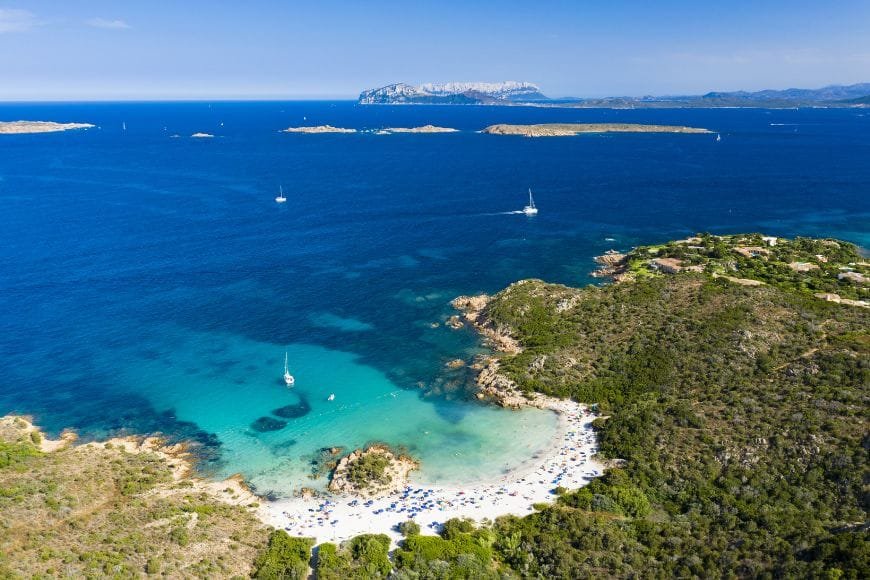
Nestled in the glamorous Costa Smeralda, Spiaggia del Principe is a crescent-shaped bay of white sand and dazzling water. Legend has it that Prince Karim Aga Khan, founder of Costa Smeralda as a luxury resort area, declared this his favorite beach — hence the name “Prince’s Beach.” Today it’s one of the best beaches in northern Sardinia, known for its chic atmosphere and stunning beauty.
When I visited, I was amazed not only by the color of the water but also by how sheltered it felt, hidden between rocky granite headlands. It’s a small but unforgettable beach, especially for those seeking the glamour of the Emerald Coast.
How to get there:
From Olbia, it’s about 30 minutes by car to Costa Smeralda. Public transport is limited, so driving is the best option.
Where to park:
A small parking area is available near the path leading down to the beach. Arrive early in peak season to secure a spot.
Where to stay near Spiaggia del Principe:
Stay in Porto Cervo or nearby resorts in Costa Smeralda for luxury options, or in Olbia for a more affordable base.
🗺️ Map Location and Directions
Cala Goloritzé: East Sardinia – UNESCO Hiking Beach
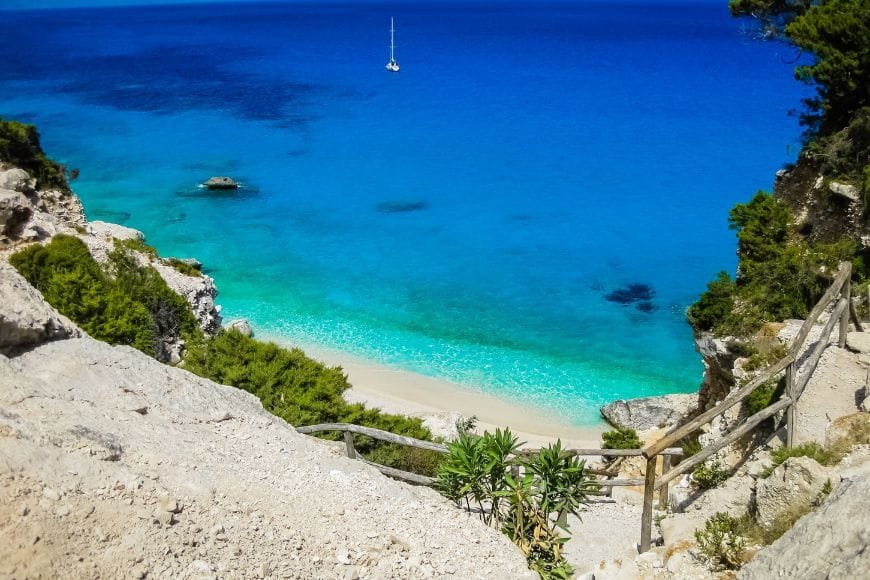
Declared a UNESCO World Heritage Site, Cala Goloritzé is one of the most unique beaches in Italy. Tucked at the base of towering limestone cliffs, it’s famous for its turquoise waters and the iconic Aguglia rock spire that rises dramatically above the cove.
I’ll never forget the sense of arrival after hiking through the rugged Supramonte hills — the beach suddenly appears like a hidden paradise, untouched and wild. Because access is limited, it feels special, almost like discovering a secret.
How to get there:
From Olbia or Cagliari, drive to Baunei or Su Porteddu, where the hiking trail begins. The hike takes about 1.5–2 hours each way. Alternatively, boat tours from Cala Gonone also visit the cove.
Where to park:
Paid parking is available at the trailhead in Su Porteddu. From there, you must continue on foot.
Where to stay near Cala Goloritzé:
Stay in Baunei or Cala Gonone, both small towns offering B&Bs and boutique hotels with access to Sardinia’s east coast.
🗺️ Map Location and Directions
Cala Luna: East Sardinia – Cave-Lined Beach on the Gulf of Orosei
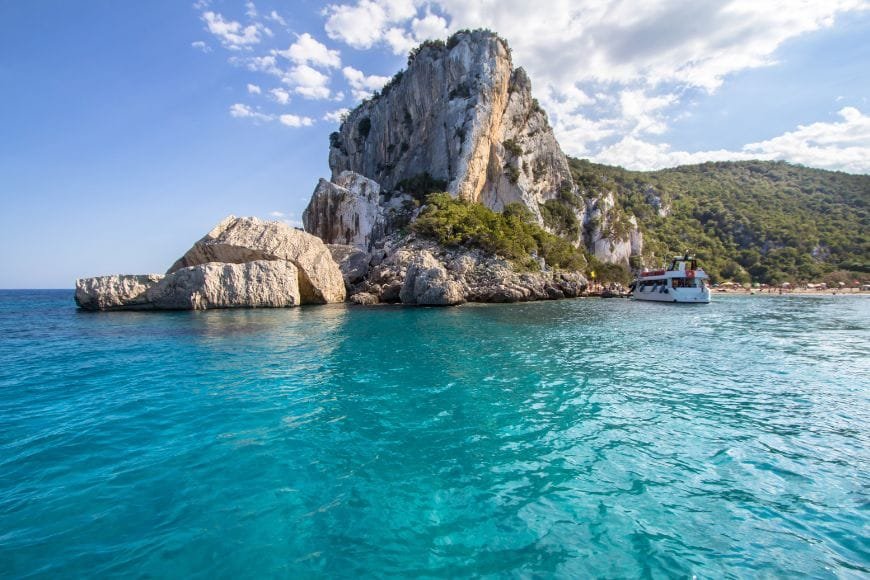
With its golden sand, turquoise water, and dramatic caves, Cala Luna is one of the best beaches in eastern Sardinia. The beach stretches beneath high cliffs, with sea caves that offer natural shade — perfect for a summer afternoon.
The first time I arrived by boat, the view was breathtaking: a sweep of sand backed by wild cliffs, with barely a sign of modern development. It’s a place that feels remote yet welcoming, ideal for both swimmers and explorers.
How to get there:
The easiest way is by boat from Cala Gonone, which takes about 30 minutes. Hikers can also reach Cala Luna on foot via a scenic 2–3 hour trail from Cala Fuili. From Olbia, drive to Cala Gonone (about 2.5 hours) to start your trip.
Where to park:
Parking is available in Cala Gonone, either at the port (for boat trips) or at Cala Fuili if hiking.
Where to stay near Cala Luna:
Stay in Cala Gonone, where family-run hotels and B&Bs make it the best base for exploring the Gulf of Orosei.
🗺️ Map Location and Directions
Most Romantic Beaches in Italy
For couples looking for a dreamy escape, Isola Bella in Taormina, Fiordo di Furore on the Amalfi Coast, and Cala Luna in Sardinia offer sunsets and settings made for romance. Whether it’s watching the Ionian Sea glow from Taormina or dining by candlelight after a swim in Atrani, these beaches are perfect for a romantic getaway.
Best Beaches for Families
Families often need shallow waters, soft sand, and facilities nearby. San Vito Lo Capo in Sicily, Monterosso in Cinque Terre, and Lido di Jesolo near Venice are among the best family beaches in Italy, offering plenty of space and calm waters where children can swim safely.
Hidden Gems Loved by Locals
If you prefer beaches off the tourist trail, try San Fruttuoso near Portofino, Maratea in Basilicata, or Cala Violina in Tuscany. These spots are less crowded but every bit as beautiful, offering a glimpse of the beaches Italians keep for themselves.
Beaches with Blue Flag Certification
Many of Italy’s beaches carry the Blue Flag for cleanliness and eco-friendliness. Notable examples include La Pelosa in Sardinia, Sperlonga in Lazio, and several beaches around Tropea in Calabria. Choosing a Blue Flag beach means you’ll find clean water, good facilities, and environmental care.
Practical Tips for Visiting Italian Beaches
Best time to go:
The beach season in Italy runs from May to September, with July and August being the hottest and busiest. For warm weather without the crowds, June and September are ideal. Spring and early autumn are also great for hiking + swimming combos in regions like Sardinia or Sicily.
How to get around:
Reaching Italy’s beaches is easier than many travelers think, but the best option depends on the region. Here are the main ways to get around:
- Train – Fast and affordable, trains connect major cities like Rome, Naples, Florence, and Milan to many coastal towns (Cinque Terre, Sperlonga, Tropea).
- Bus – Useful for reaching smaller towns or transferring from train stations. Essential on the Amalfi Coast and in parts of Sardinia and Sicily.
- Ferry – The easiest way to visit islands and coves like Elba, Isola Bella, San Fruttuoso, and Lampedusa.
- Car rental – Recommended in regions with limited public transport such as Sardinia, Calabria, and Basilicata. Great for exploring hidden coves, but always watch out for ZTL zones in historic towns.
Costs: Free vs Private Lidos:
Many Italian beaches are divided into free public areas (spiaggia libera) and private clubs (stabilimenti balneari). A lido usually provides a lounger, umbrella, showers, and café service. Prices range from €15–30 per day in most places, higher on the Amalfi Coast and Sardinia.
Parking & ZTL zones:
Parking near beaches can be expensive and limited, especially in historic towns like Amalfi or Tropea. Always check for ZTL zones (restricted traffic areas) in Italian towns — entering without a permit can lead to heavy fines. When possible, park outside the center and walk or use shuttles.
What to pack:
Beach shoes for rocky or pebble beaches (Cinque Terre, Elba, Amalfi Coast).
- Reef-safe sunscreen — some regions ban harmful chemicals.
- Lightweight beach umbrella for shade on free beaches.
- Cash for parking, small cafés, or renting loungers (not everywhere takes cards).
- Reusable water bottle & snacks — especially for hidden coves without facilities.
- Dry bag if you plan to take boat trips (Cala Goloritzé, Cala Luna, San Fruttuoso).
❓ FAQs About Beaches in Italy
What is the most famous beach in Italy?
Spiaggia dei Conigli (Rabbit Beach) in Lampedusa is often ranked among the world’s most beautiful beaches and is considered the most famous in Italy.
Are Italian beaches free or do you have to pay?
Both exist. Free public areas (spiagge libere) are common, but many stretches are run by private beach clubs (lidi), where you pay for umbrellas, loungers, and facilities.
Which beaches are easiest to reach without a car?
Many top beaches are connected by train and bus, including Monterosso (Cinque Terre), Sperlonga (near Rome), and Tropea (Calabria). Islands like Elba and Isola Bella are also easy to access by ferry.
What are the best beaches in Italy for families?
San Vito Lo Capo in Sicily, Monterosso in Cinque Terre, and Lido di Jesolo near Venice are among the best family-friendly options thanks to shallow water and plenty of facilities.
When is the best time to visit Italy’s beaches?
The ideal months are June and September — warm weather, swimmable seas, and fewer crowds than peak July–August.
Final Words
Italy’s coastline is as diverse as its culture. From the dramatic cliffs of the Amalfi Coast, to the wild coves of Sardinia, to the volcanic sands of Sicily, every region offers beaches that feel uniquely its own. Some are world-famous, like Rabbit Beach in Lampedusa, while others, like San Fruttuoso or Maratea, remain hidden gems known mostly to locals.
Having lived here for over 20 years, I can tell you that Italy’s beaches are more than just places to swim — they’re where history, culture, and natural beauty all come together. Whether you’re looking for a romantic escape, a family holiday, or an off-the-beaten-path adventure, these 22 beaches show why Italy belongs on every traveler’s seaside bucket list.
👉 Ready to plan your trip? Check out our related Italy travel guides:
Get our FREE Italy
Travel Guide
E-Book
This printable guide is your ultimate companion for exploring Italy, with insider tips, detailed itineraries, transportation advice, must-see attractions, and more.

💬 We’d love to hear from you!
Have questions, tips, or personal travel stories to share? Drop them in the comments below — your insights help fellow travelers plan their adventures too.
